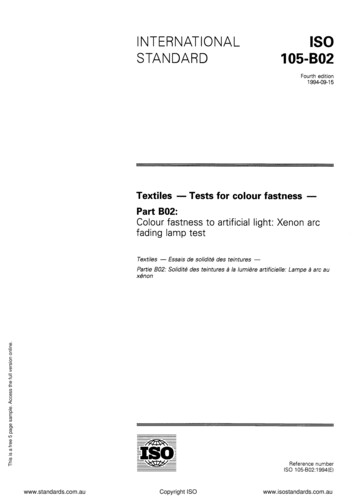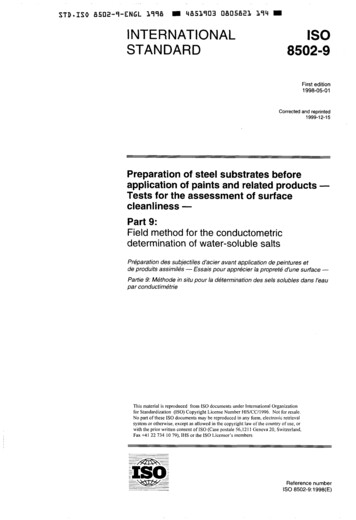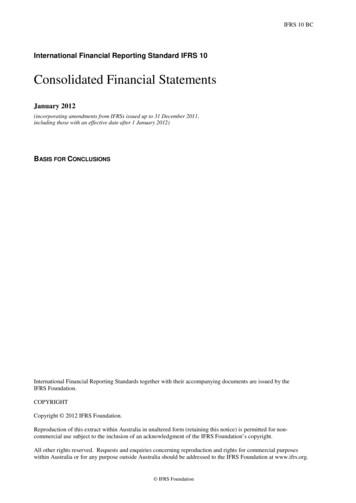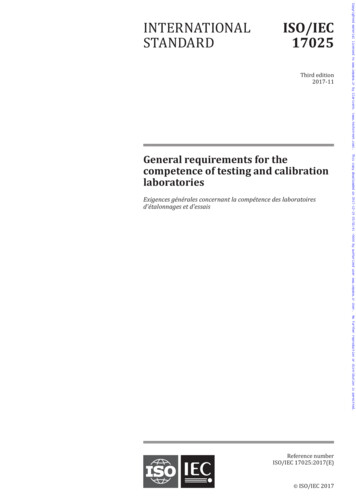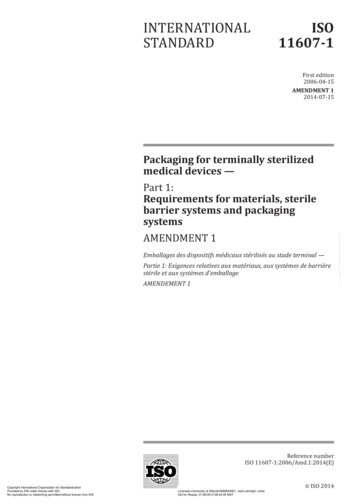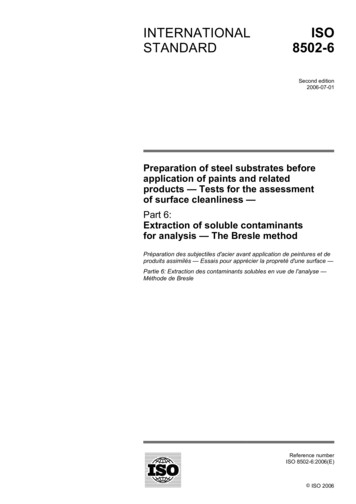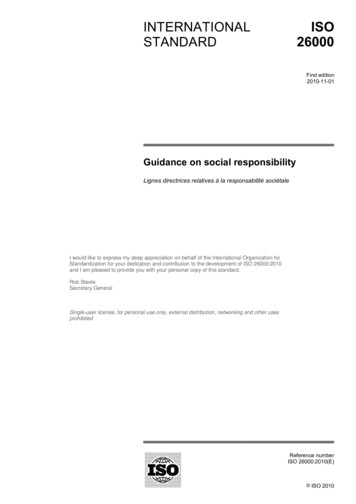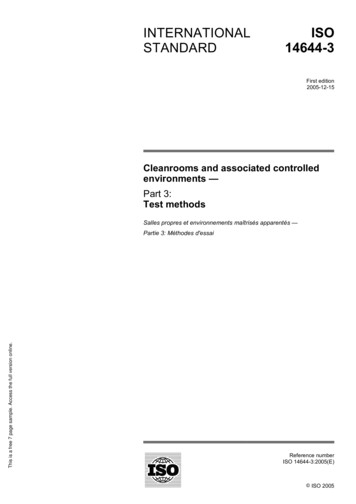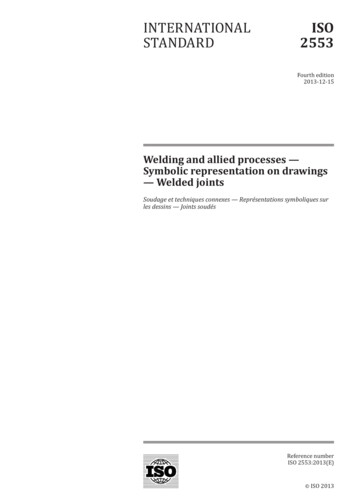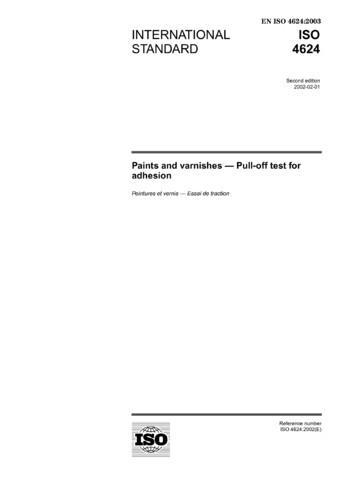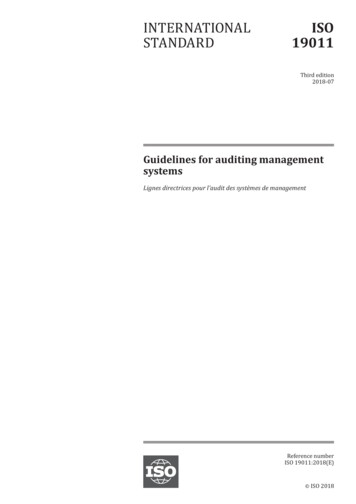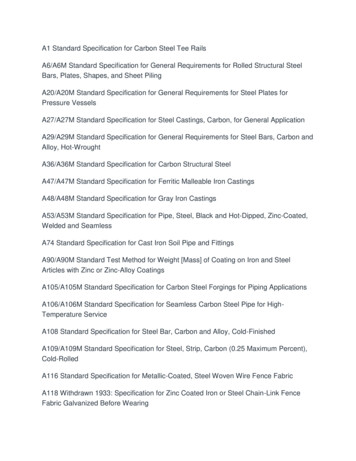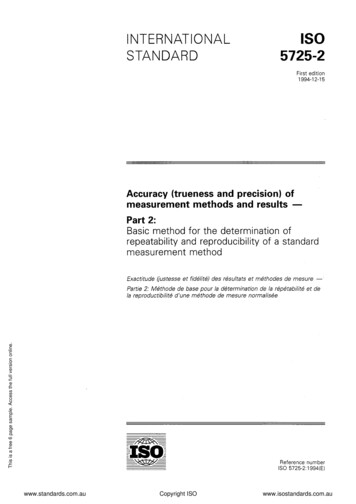
Transcription
Is05725-2INTERNATIONALSTANDARDFirst edition1994-12-15Accuracy (trueness and precision) ofmeasurementmethods and results Part 2:Basic method for the determination ofrepeatability and reproducibility of a standardmeasurement methodExactitude (justesse et fidglitk) des r&ultatset mkthodesde mesure -.This is a free 6 page sample. Access the full version online.Partie 2: Mkthode de base pour la d6 termina tion de la rkp6 tabilit6 et dela reproductibilit6 d’une m&hode de mesure normalis6eReference numberIS0 5725-2:1994(E)www.standards.com.auCopyright ISOwww.isostandards.com.au
IS0 5725 2:1994(E)ContentsPage1Scope . . . . . . . . . . . . . . . . . . . . . . . . . . . . . . . . . . . . . . . . . . . . . . . . . 12Normative references3Definitions4Estimates of the parameters5Requirements. . . . . . . . . . . . . . . . . . . . . . . . . . . . . . . . . . . . . . . . . . . . 2in the basic modelfor a precision experiment. . . . . . . . . . . . 2. . . . . . . . . . . . . . . . . . 2. . . . . . . . . . . . . . . . . . . . . . . . . . . . . . . . 25.1Layout of the experiment5.2Recruitment5.3Preparation of the materials6. . . . . . . . . . . . . . . . . . . . . . . . . . . 3of the laboratories. . . . . . . . . . . . . . . . . . . . . . . . . . . . . . 3. . . . . . . . . . . . . . . . 5Personnel involved in a precision experiment. . . . . . . . . . . . . . . . . . . . . . . . . . . . . . . . . . . .*.56.1Panel6.2Statistical functions. . . . . . . . . . . . . . . . .*.6.3Executive functions. . . . . . . . . . . . . . . . . . . . . . . . . . . . . . . . . . . . 56.4Supervisors6.5Operators7This is a free 6 page sample. Access the full version online. . . . . . . . . . . . . . . . . . . . . . . . . . . . . . . . . . . . . 25. . . . . . . . . . . . . . . . . . . . . . . . . . . . . . . . . . . . . . . . . . . 5. . . . . . . . . . . . . . . . . . . . . . . . . . . . . . . . . . . . . . . . . . . . . . 6. . . . . . . . . . . . . . 6Statistical analysis of a precision experiment. . . . . . . . . . . . . . . . . . . . . . . . . . . . . . . 67.1Preliminary considerations7.2Tabulation of the results and notation used7.3Scrutiny of results for consistencyand outliers. . . . . . . . . . . . . 97.4Calculation of the general mean and variances. . . . . . . . . . . 137.5Establishing a functional relationship between precision values and. . . . . . . . . . . . . . . . . . . . . . . . . . . . . . . . . . . . . . 14the mean level m7.6Statistical analysis as a step-by-step7.7The report to, and the decisions to be taken by, the panel8Statistical tables. . . . . . . . . . . . . . 7procedure. . . . . . . . . . 1620. . . . . . . . . . . . . . . . . . . . . . . . . . . . . . . . . . . . . . . . 218 IS0 1994All rights reserved. Unless otherwise specified, no part of this publication may be reproducedor utilized in any form or by any means, electronic or mechanical, including photocopying andmicrofilm, without permission in writing from the publisher.International Organization for StandardizationCase Postale 56 l CH-1211 Geneve 20 l SwitzerlandPrinted in Switzerlandiiwww.standards.com.auCopyright ISOwww.isostandards.com.au
IS0 5725 2:1994(E)0 IS0Annexesused in IS0 5725. . . . . . . . . . . . . . 25ASymbols and abbreviationsBExamples of the statistical analysis of precision experiments27B.lExample 1: Determination of the sulfur content of coal (Several. . . . . . . . . . . . . . . . . . . 27levels with no missing or outlying data)B.2Example 2: Softening point of pitch (Several levels with missing. . . . . . . . . . . . . . . . . . . . . . . . . . . . . . . . . . . . . . . . . . . . . . . . . 32data)B.3Example 3: Thermometric titration of creosote oil (Several levels. . . . . . . . . . . . . . . . . . . . . . . . . . . . . . . . . . . . . . . . . 36with outlying data)Bibliography. . . . . . . . . . . . . . . . . . . . . . . . . . . . . . . . . . . . . . . . . . . . . 42This is a free 6 page sample. Access the full version online.C. .IIIwww.standards.com.auCopyright ISOwww.isostandards.com.au
0 IS0IS0 5725-2: 1994(E)ForewordIS0 (the International Organization for Standardization) is a worldwidefederation of national standards bodies (IS0 member bodies). The workof preparing International Standards is normally carried out through IS0technical committees.Each member body interested in a subject forwhich a technical committee has been established has the right to berepresented on that committee. International organizations, governmentaland non-governmental, in liaison with ISO, also take part in the work. IS0collaborates closely with the International Electrotechnical Commission(IEC) on all matters of electrotechnical standardization.Draft International Standards adopted by the technical committees arecirculated to the member bodies for voting. Publication as an InternationalStandard requires approval by at least 75 % of the member bodies castinga vote.International Standard IS0 5725-2 was prepared by Technical CommitteelSO/TC 69, Applicationsof statistical methods, SubcommitteeSC 6,Measurement methods and results.This is a free 6 page sample. Access the full version online.IS0 5725 consists of the following parts, under the general title Accuracy(trueness and precision) of measurement methods and results:-Part I: General principles and definitions-Part 2: Basic method for the determination of repeatabilityproducibility of a standard measurement method-Part 3: Intermediatemeasuresmeasurement method-Part 4: Basic methodsstandard measurement-Part 5: Alternative methods for the determinationof a standard measurement method-Part 6: Use in practice of accuracy valuesof the precisionfor the determinationmethodand re-of a standardof the truenessof aof the precisionParts I to 6 of IS0 5725 together cancel and replace IS0 5725:1986,which has been extended to cover trueness (it7 addition to precision) andintermediate precision conditions (in addition to repeatability and reproducibility conditions).Annex A forms an integra I part of this part of IS0 5725. AnnexesC are for information only.www.standards.com.auCopyright ISOB andwww.isostandards.com.au
IS0 5725-2: 1994(E)0 IS0Introduction0.1IS0 5725 uses two terms “trueness”and “precision” to describethe accuracy of a measurement method. “Trueness” refers to the closeness of agreement between the arithmetic mean of a large number of testresults and the true or accepted reference value. “Precision” refers to thecloseness of agreement between test results.0.2 General consideration of these quantities is given in IS0 5725-l andso is not repeated in this part of IS0 5725. IS0 5725-l should be read inconjunction with all other parts of IS0 5725, including this part, becauseit gives the underlying definitions and general principles.0.3 This part of IS0 5725 is concerned solely with estimating by meansof the repeatability standard deviation and reproducibility standard deviation. Although other types of experiment (such as the split-level experiment) are used in certain circumstances for the estimation of precision,they are not dealt with in this part of IS0 5725 but rather are the subjectof IS0 5725-5. Nor does this part of IS0 5725 consider any other measures of precision intermediate between the two principal measures; thoseare the subject of IS0 5725-3.0.4This is a free 6 page sample. Access the full version online.In certain circumstances,the data obtained from an experimentcarried out to estimate precision are used also to estimate trueness. Theestimation of trueness is not considered in this part of IS0 5725; all aspects of the estimation of trueness are the subject of IS0 5725-4.www.standards.com.auCopyright ISOwww.isostandards.com.au
left blankThis is a free 6 page sample. Access the full version online.This page intentionallywww.standards.com.auCopyright ISOwww.isostandards.com.au
This is a free 6 page sample. Access the full version online.ISO 5725-2:1994 Accuracy (trueness and precision) ofmeasurement methods and results - Part 2: Basic method forthe determination of repeatability and reproducibility of astandard measurement methodThe remainder of this documentis available for purchase online atwww.saiglobal.com/shopSAI Global also carries a wide range of publications from a wide variety of Standards Publishers:Click on the logos to search the database online.
0 IS0 IS0 5725-2: 1994(E) Introduction 0.1 IS0 5725 uses two terms “trueness” and “precision” to describe the accuracy of a measurement method. “Trueness” refers to the close- ness of agreement between the arithmetic mean of a large number of test results and the true or accepted reference value. “Precision” refers to the
